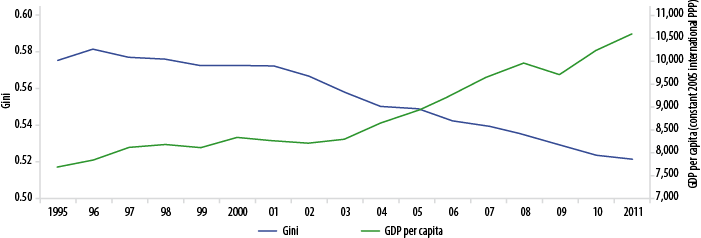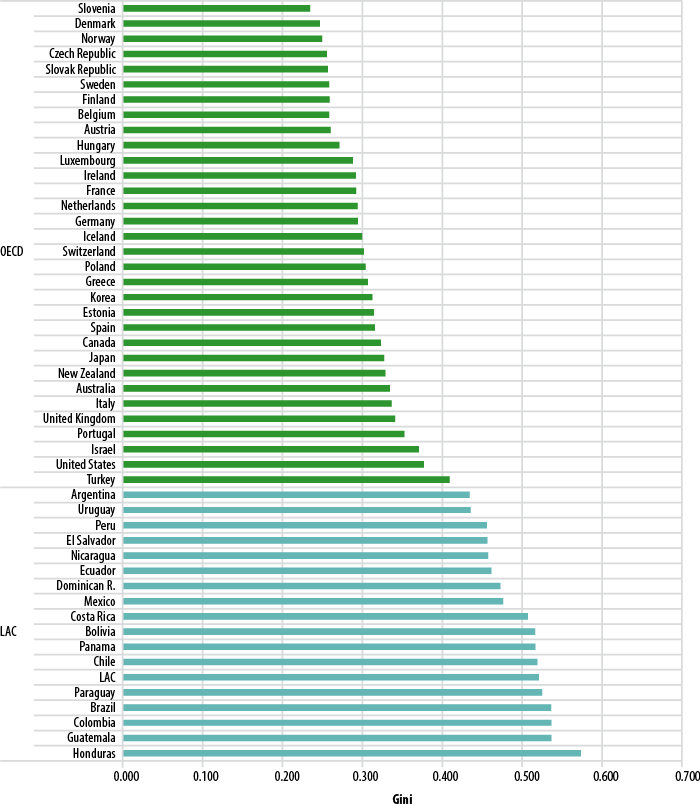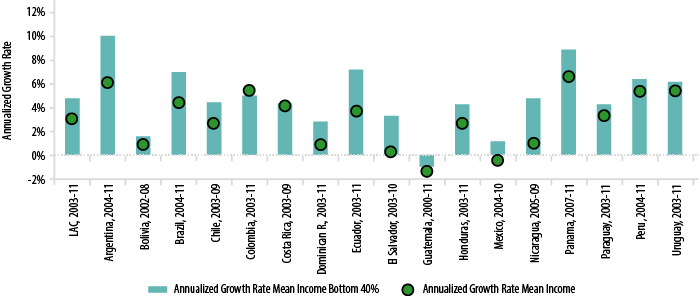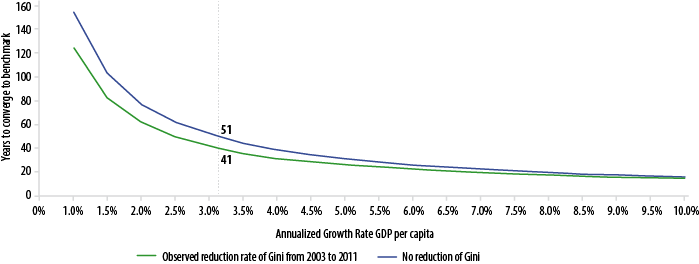The Latin America and Caribbean region (LAC) has long been considered the most unequal region in the world. Regardless of whether this stems from a legacy of colonisation or is a 20th century phenomenon (Williamson 2009), the fact remains that the region has some of the highest levels of inequality in the world. However, over the past 15 years both poverty and inequality have declined sharply throughout the region. This marks the first time in the region’s history when both have seen a prolonged and substantial reduction, a phenomenon explored in many recent VoxEU columns (e.g. Lopez-Calva and Lustig 2010, de la Torre and Messina 2013).
In our World Bank unit’s recent research, we analyse these trends, assess them in a comparative perspective, and raise the question of the sustainability of equitable growth. We also present a new metric that can be utilised to compare the welfare of LAC countries to those that experience the highest levels of social welfare worldwide.
Over a decade and a half of declining poverty and inequality
Since 1995, LAC has seen extreme poverty (set at $2.50 PPP/day) cut in half – from 26% to less than 13% (World Bank 2013). Furthermore, 2011 marked the first time in the region’s history that the middle class constituted a larger portion of the population than the poor (using a poverty line of $4 PPP/day) (see Figure 1). However, despite the impressive reduction in poverty and the unprecedented growth of the middle class, the largest segment of the region’s population still remains vulnerable to falling back into poverty, with 40% of the population as of 2011 living with incomes above the poverty line ($4 PPP/day) but below the middle class threshold ($10 PPP/day). This group is referred to as vulnerable because they are neither poor nor economically secure as they are prone to falling into poverty as a result of economic or household shocks (López-Calva and Ortiz-Juarez 2012). The relative size of this vulnerable population has remained largely stable, as those escaping poverty enter the vulnerable class, and the vulnerable in turn become the middle class.
Figure 1 Trends in socio economic groups
Source: World Bank. 2013. “Shifting Gears to Accelerate Shared Prosperity.” Latin America and Caribbean Poverty and Labor Brief, June, World Bank, Washington, DC.
Note: Calculations using Socio-Economic Database for Latin America and the Caribbean (SEDLAC) data (Centro de Estudios Distributivos Laborales y Sociales at the University of La Plata [CEDLAS] and the World Bank). The poor are those living on less than $4 a day (including the extreme poor), the vulnerable are those living on $4 to $10 a day, and the middle class are those living on $10 to $50 a day (all in 2005 purchasing power parity). In order to analyze the same set of countries every year, interpolation was applied when country data was not available for a given year.
Both high growth and falling inequality accompanied these trends in poverty reduction and have persisted throughout the decade despite a slight dip in growth during the recent global financial crisis (see Figure 2). The accompaniment to growth of an improvement in the distribution of income is in stark contrast to many other regions and countries throughout the world, particularly India and China, where growth has been relatively more beneficial to the rich, thus, leading to widening inequality.
Figure 2 Economic growth and inequality
Source: World Bank. 2013. “Shifting Gears to Accelerate Shared Prosperity.” Latin America and Caribbean Poverty and Labor Brief, June, World Bank, Washington, DC.
Note: Calculations using SEDLAC data (CEDLAS and the World Bank).
Several factors are driving poverty and inequality reduction in the region.
- Although remittances and government transfers have been important (Lopez-Calva and Lustig 2010), recent empirical work suggests that the leading cause of the decline in poverty and inequality has been growth in labour earnings (Torre and Messina 2013) (see Figure 3).
- In addition to increased returns to labour, labour earnings growth also reflects rising labour force participation, particularly among women, especially those in the bottom quintile, and changing demographics leading to higher ratio of adults/dependents in the work force (World Bank 2012).
Figure 3 Inequality decomposition
Source: World Bank. 2013. “Shifting Gears to Accelerate Shared Prosperity.” Latin America and Caribbean Poverty and Labor Brief, June, World Bank, Washington, DC.
Note: Calculations using SEDLAC data (CEDLAS and the World Bank).
Nonetheless, although the decline in poverty and inequality has been impressive, Latin America remains one of the most unequal regions in the world. For example, the most equal countries in Latin America – Argentina and Uruguay – are still more unequal than the least equal among all of the non-LAC OECD countries (see Figure 4). Furthermore, as discussed in the previous section, the largest segment of the population is considered vulnerable to falling back into poverty (see Figure 1). This suggests that there is still much work to be done in Latin America toward creating a more equitable society.
Figure 4 Global inequality
Source: World Bank. 2013. “Shifting Gears to Accelerate Shared Prosperity.” Latin America and Caribbean Poverty and Labor Brief, June, World Bank, Washington, DC.
Note: Calculations using SEDLAC data (CEDLAS and the World Bank).
Measuring prosperity
The World Bank President, Jim Yong Kim, recently called on the global community to work toward promoting shared prosperity and ending extreme poverty by 2030. These new goals were outlined by President Kim at the 2013 IMF-World Bank Spring Meetings (Kim 2013) to help ensure that equity and inclusion feature prominently in national and global policymaking.
Today, 80 million people still live in extreme poverty in LAC by regional standards ($2.50/day), half of them in Brazil and Mexico. Still, with its recent gains, the region is on track to ending extreme poverty in the coming years.
But how quickly are countries in the region moving toward shared prosperity? Consistent with the substantial decline in inequality, the average income of those in the bottom 40% has grown rapidly over the past decade and has grown faster than mean per capita income (see Figure 5).
Figure 5 Growth of the bottom 40% in LAC, 2003-2011
Source: World Bank. 2013. “Shifting Gears to Accelerate Shared Prosperity.” Latin America and Caribbean Poverty and Labor Brief, June, World Bank, Washington, DC.
Note: Calculations using SEDLAC data (CEDLAS and the World Bank).
However, shared prosperity can also be interpreted more broadly to imply the closing of the gap in the standard of living between poor and prosperous nations. To explore whether these gaps are narrowing over time, the Shared Prosperity Convergence Index (SPCI) accounts for differences in the aggregate welfare of the population of various countries. This measure is the gap between the Sen’s Welfare Index (GDP per capita adjusted by income inequality or one minus the gini times GDP per capita, Sen 1976) for any given country with respect to the average Sen’s index of the top ten global performers in 2000.1 This measure can then be interpreted as the gap between a country’s level of well-being and the ten countries with the highest level of well-being at the turn of the century.
Using this metric, welfare varies along two dimensions – the average income level, and the level of economic inequality. As discussed above, Latin America has made rapid progress in both these areas over the past 15 years. As a result, it has narrowed the gap in wellbeing between the region and the world’s top performers (see Figure 6). However, the region has currently only attained approximately 20% of the benchmark nations and progress has not been homogeneous throughout the region, with the Southern Cone (Argentina, Chile, Paraguay, and Uruguay) and Mexico converging more rapidly than Central America and the Andean regions.
Figure 6 Trends in shared prosperity in LAC, measured by SPCI
Source: World Bank. 2013. “Shifting Gears to Accelerate Shared Prosperity.” Latin America and Caribbean Poverty and Labor Brief, June, World Bank, Washington, DC.
Note: Gini coefficients are calculated using pooled data of countries, while GDP per capita .figures for LAC and sub-region are population-weighted average of countries. The Sen’s Welfare Index benchmark is 23,535 (equity-adjusted per capita GDP per year, PPP 2005), derived from the population-weighted average of the Sen’s Welfare Index of the top ten countries in 2000 (Luxembourg, Qatar, Norway, Denmark, United States, Netherlands, Switzerland, Austria, Ireland and Singapore).
Economic growth is not enough to rapidly boost shared prosperity. Assuming that LAC can maintain the annual 3.1% rate of economic growth seen over the past decade – which is uncertain as economic growth appears to be slowing in the region – it would take until 2062 for the region to reach the level of welfare seen by the top performers in 2000 (see Figure 7). However, if growth continues to be equalising, as it has been over the past decade, gains can be made along both of the shared prosperity dimensions, decreasing the amount of time required to reach the benchmark by as much as ten years (assuming the same pace of inequality reduction achieved between 2003 and 2011). Thus, in addition to sustainable growth, inequality reduction is crucial in accelerating the progress LAC makes towards attaining the World Bank’s shared prosperity goals.
Figure 7 Years till shared prosperity convergence
Source: World Bank. 2013. “Shifting Gears to Accelerate Shared Prosperity.” Latin America and Caribbean Poverty and Labor Brief, June, World Bank, Washington, DC.
Note: Calculations using SEDLAC data (CEDLAS and the World Bank). The benchmark refers to the population-weighted average of the Sen’s Welfare Index of the top ten countries in 2000 (Luxembourg, Qatar, Norway, Denmark, United States, Netherlands, Switzerland, Austria, Ireland and Singapore).
Concluding remarks
Despite the impressive progress on poverty and inequality reduction over the past 15 years in LAC, the region still has a long way to go to reach the same levels of prosperity as those experienced by the most equitable and wealthy nations. It is increasingly important that countries in the region protect the wellbeing of the vulnerable in addition to those who live in poverty. Ensuring that the vulnerable do not slip back into poverty is paramount if poverty reduction is to continue at the rate seen to date in this millennium. While much work has been done to understand how to reduce poverty, identifying the issues that affect the vulnerable and providing them with the opportunities to sustainably enter the middle class is an important area for further research.
Disclaimer: The views expressed here are those of the authors and do not necessarily represent those of the institutions with which they are affiliated.
References
de la Torre, A and J Messina (2013), "The trend reversal in income inequality and returns to education: How bad is this good news for Latin America?" VoxEU.org, 7 March.
Kim, J Y (2013), "Within Our Grasp: A World Free of Poverty - World Bank Group President Jim Yong Kim’s Speech at Georgetown University." The World Bank. April 2, (accessed September 9, 2013))
Lopez-Calva, L F and E Ortiz-Juarez (2013), "A Vulnerability Approach to the Definition of the Middle Class", Journal of Economic Inequality.
Lopez-Calva, L and N Lustig (2010), "Declining Latin American inequality: Market forces or state action?" VoxEU.org, 6 June.
Sen, A (1976),"The Measurement of Poverty: An Axiomatic Approach." Econometrica 44: 219-232.
Williamson, J G (2009),"Latin American Inequality Since 1491", VoxEU.org, 12 September.
World Bank (2013), "Shifting Gears to Accelerate Shared Prosperity in LAC: Ending Extreme Poverty and Promoting Shared Prosperity in Latin America and the Caribbean", Poverty and Labor Brief, Washington, DC: World Bank.
World Bank (2012), “The Effect of Women's Economic Power in Latin America and the Caribbean”, Poverty and Labor Brief, Washington, DC: World Bank.
1 The population weighted average of Luxembourg, Qatar, Norway, Denmark, the United States, the Netherlands, Switzerland, Austria, Ireland and Singapore. The average Sen’s Welfare Index for the benchmark countries is 23,535.













